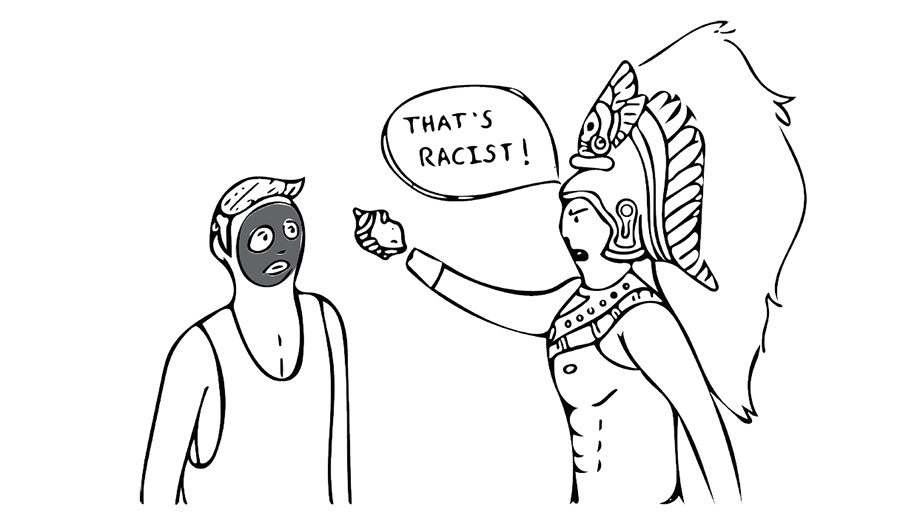For the third year in a row the San Diego State men’s basketball team wore turquoise uniforms as part of the N7 program to — as GoAztecs.com claims — honor Native American Heritage Month.
And for the 91st year, SDSU encouraged and sanctioned cultural appropriation inherent in its racist moniker, “Aztecs.”
The irony of this is apparently lost on the university, the athletics department and fans of the team. But one cannot blame students and student athletes for participating in these racist mockeries of native cultures. Their ignorance is enabled by the abject failure of their educational institution to enact meaningful and overdue change regarding its problematic iconography.
Despite what those ubiquitous bookstore T-shirts say, we are not Aztecs. The Aztecs were an empire that grew out of a few central Mexican cultures: the Toltecs, Otomi and Chichimeca. Their culture and empire was destroyed by Spanish conquest in the 16th century. While many students might trace their heritage to central and southern Mexico, there is no current organized group or tribe related to the Aztecs.
SDSU was able to dodge an NCAA ban on Native American mascots in 2005. The president at the time, Stephen Weber, said he did not consider Aztecs to be either Native American or American Indian because they were from Mexico.
Chew on that. The president of a major university said Aztecs were not Native American but Mexican. This is how SDSU avoided the ban on Native American mascots. According to Weber, Mexico is not America. This cultural ignorance is what enabled Aztecs to become the mascot in the first place and its perpetuation allows it to remain so well into the 21st century.
Ozzie Monge, an American Indian Studies lecturer, has brought issues with the mascot back to the forefront with the publication of his master’s thesis, “Fail Montezuma!” In it Monge argues that the genesis of the mascot is rooted in white supremacy and cultural appropriation.
“The mascot itself perpetuates the noble savage stereotype, reducing Indigenous people to anachronistic objects for use as a good luck charm during sporting events,” Monge wrote in his thesis. “This is completely antithetical to SDSU’s achievements in diversity.”
Monge found in his research that people in the region incorrectly believed the Aztecs were a local tribe. Video and images from early in SDSU’s history show students dressed as stereotypical plains Indians, complete with teepees and feathered headdresses. An article defending the mascot published in the Daily Aztec just two years ago makes the same erroneous connection. The Aztec Empire never stretched any closer than 1800 miles to San Diego. The connection is rooted in ignorance.
Monge said he was supportive of the N7 initiative, however, and that he thought it was a positive for native communities.
“The N7 event benefits a really cool program called Inter Tribal Sports,” Monge wrote in an email. “The kids love coming to see a basketball game.”
Given the weight of evidence and history of SDSU, it is difficult to accept that the university is interested in honoring Native American heritage, however, when they rely on ignorance to preserve their racist moniker.
The institution is heavily invested in maintaining its brand. Make no mistake, that is all this is about — branding.
From the time students begin considering attending SDSU, the school begins cramming its Aztec brand down their throats. Everything at this university — including this newspaper — is draped in racist “Aztec” branding.
A robust alumni network is similarly attached to the Aztec mythos SDSU marketers work tirelessly to maintain. Past efforts to change the mascot have been hampered by these alumni. Why should racist iconography continue in perpetuity to appease the nostalgia of past students? Healthy, functioning people should not wrap their identity in corporate branding, but that is exactly what SDSU strives for in its students and alumni.
Two university websites — GoAztecs.com and MySDSU’s admissions page — have, this year, featured white students wearing stereotypical Native American face paint, a practice considered by many to be comparable to blackface.
In a letter to President Eliot Hirshman dated Nov. 17, Monge said that by allowing an inherently racist institutional identity to continue the university granted students license to engage in “racial drag” or “redface.”
The photo on GoAztecs was removed after Monge posted it to his “Fail Montezuma” Facebook page. The photo on MySDSU has similarly disappeared.
Proponents of the culturally insensitive brand argue that it creates a sense of community and school pride. But how much pride can really be found in something representative of a legacy of colonialism and genocide? Even the architecture of the university, designed to mimic a Spanish colonial mission, reflects this.
Monge compares the issue with that of other marginalized groups.
“I wonder how different things would be if the school’s architecture was based on a plantation with a pickaninny or mammy mascot,” he said. “But the nature of racism against Native Americans in this country is so pernicious, it’s normalized.”
If SDSU was truly interested in honoring Native American heritage, it would sweep its racist mascot and moniker into the dustbin of history — where they belong — not just change the color of its basketball team’s jersey for one game a year. That, however, will require more students and alumni to stand up, once and for all, for what is right.
“Therein lies the rub,” Monge said. “They’re counting on people not knowing the truth to keep the Aztec nonsense going. A university that tries to keep people ignorant — ain’t that grand?”









